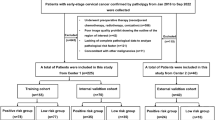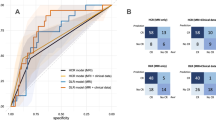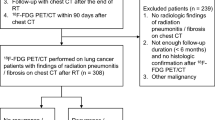Abstract
Background
We designed a deep learning model for assessing 18F-FDG PET/CT for early prediction of local and distant failures for patients with locally advanced cervical cancer.
Methods
All 142 patients with cervical cancer underwent 18F-FDG PET/CT for pretreatment staging and received allocated treatment. To augment the amount of image data, each tumor was represented as 11 slice sets each of which contains 3 2D orthogonal slices to acquire a total of 1562 slice sets. In each round of k-fold cross-validation, a well-trained proposed model and a slice-based optimal threshold were derived from a training set and used to classify each slice set in the test set into the categories of with or without local or distant failure. The classification results of each tumor were aggregated to summarize a tumor-based prediction result.
Results
In total, 21 and 26 patients experienced local and distant failures, respectively. Regarding local recurrence, the tumor-based prediction result summarized from all test sets demonstrated that the sensitivity, specificity, positive predictive value, negative predictive value, and accuracy were 71%, 93%, 63%, 95%, and 89%, respectively. The corresponding values for distant metastasis were 77%, 90%, 63%, 95%, and 87%, respectively.
Conclusion
This is the first study to use deep learning model for assessing 18F-FDG PET/CT images which is capable of predicting treatment outcomes in cervical cancer patients.
Key Points
• This is the first study to use deep learning model for assessing 18 F-FDG PET/CT images which is capable of predicting treatment outcomes in cervical cancer patients.
• All 142 patients with cervical cancer underwent 18 F-FDG PET/CT for pretreatment staging and received allocated treatment. To augment the amount of image data, each tumor was represented as 11 slice sets each of which contains 3 2D orthogonal slices to acquire a total of 1562 slice sets.
• For local recurrence, all test sets demonstrated that the sensitivity, specificity, positive predictive value, negative predictive value, and accuracy were 71%, 93%, 63%, 95%, and 89%, respectively. The corresponding values for distant metastasis were 77%, 90%, 63%, 95%, and 87%, respectively.




Similar content being viewed by others
Abbreviations
- 18F-FDG PET/CT:
-
18F-fluorodeoxyglucose positron emission tomography-computed tomography
- CRT:
-
Chemoradiotherapy
- CTV:
-
Clinical target volume
- HGRE:
-
High gray-level run emphasis
- MTV:
-
Metabolic tumor volume
- PLNs:
-
Pelvic lymph nodes
- SUV:
-
Standardized uptake value
- VOI:
-
Volume of interest
References
Rose PG, Java J, Whitney CW et al (2015) Nomograms predicting progression-free survival, overall survival, and pelvic recurrence in locally advanced cervical cancer developed from an analysis of identifiable prognostic pactors in patients from NRG Oncology/Gynecologic Oncology Group randomized trials of chemoradiotherapy. J Clin Oncol 33:2136–2142
Kang S, Nam BH, Park JY et al (2012) Risk assessment tool for distant recurrence after platinum-based concurrent chemoradiation in patients with locally advanced cervical cancer: a Korean Gynecologic Oncology Group Study. J Clin Oncol 30:2369–2374
Kidd EA, Siegel BA, Dehdashti F, Grigsby PW (2007) The standardized uptake value for F18 fluoro-deoxyglucose is a sensitive predictive biomarker for cervical cancer treatment response and survival. Cancer 110:1738–1744
Tixier F, Le Rest CC, Hatt M et al (2011) Intratumor heterogeneity characterized by textural features on baseline 18F-FDG PET images predicts response to concomitant radiochemotherapy in esophageal cancer. J Nucl Med 52:369–378
Cook GJ, Yip C, Siddique M et al (2013) Are pretreatment 18F-FDG PET tumor textural features in non-small cell lung cancer associated with response and survival after chemoradiotherapy? J Nucl Med 54:19–26
Hatt M, Majdoub M, Vallières M et al (2015) 18F-FDG PET uptake characterization through texture analysis: investigating the complementary nature of heterogeneity and functional tumor volume in a multi-cancer site patient cohort. J Nucl Med 56:38–44
Ohri N, Duan F, Snyder BS et al (2016) Pretreatment 18FDG-PET textural features in locally advanced non-small cell lung cancer: secondary analysis of ACRIN 6668/RTOG 0235. J Nucl Med 57:842–848
Kidd EA, Grigsby PW (2008) Intratumoral metabolic heterogeneity of cervical cancer. Clin Cancer Res 14:5236–5524
Yang F, Thomas MA, Dehdashti F, Grigsby PW (2013) Temporal analysis of intratumoral metabolic heterogeneity characterized by textural features in cervical cancer. Eur J Nucl Med Mol Imaging 40:716–727
Ho KC, Fang YH, Chung HW et al (2016) A preliminary investigation into textural features of intratumoral metabolic heterogeneity in FDG PET for overall survival prognosis in patients with bulky cervical cancer treated with definitive concurrent chemoradiotherapy. Am J Nucl Med Mol Imaging 6:166–175
Lucia F, Visvikis D, Desseroit MC et al (2018) Prediction of outcome using pretreatment 18F-FDG PET/CT and MRI radiomics in locally advanced cervical cancer treated with chemoradiotherapy. Eur J Nucl Med Mol Imaging 45:768
Chen SW, Shen WC, Hsieh TC et al (2018) Textural features of cervical cancers on FDG-PET/CT associate with survival and local relapse in patients treated with definitive chemoradiotherapy. Sci Rep 8:11859
Hatt M, Tixier F, Pierce L, Kinahan PE, Le Rest CC, Visvikis D (2017) Characterization of PET/CT images using texture analysis: the past, the present any future? Eur J Nucl Med Mol Imaging 44:151–165
Sollini M, Cozzi L, Antunovic L, Chiti A, Kirienko M (2017) PET Radiomics in NSCLC: state of the art and a proposal for harmonization of methodology. Sci Rep 7:358
Liew C (2018) The future of radiology augmented with artificial intelligence: a strategy for success. Eur J Radiol 102:152–156
Krizhevsky A, Sutskever I, Hinton GE (2012) Imagenet classification with deep convolutional neural networks. Adv Neural Inf Process Syst 25:1097–1105
LeCun Y, Bengio Y, Hinton G (2015) Deep learning. Nature 521:436–444
Chartrand G, Cheng PM, Vorontsov E et al (2017) Deep learning: a primer for radiologists. Radiographics 37:2113–2131
Esteva A, Kuprel B, Novoa RA et al (2017) Dermatologist-level classification of skin cancer with deep neural networks. Nature 542:115–118
Anthimopoulos M, Christodoulidis S, Ebner L, Christe A, Mougiakakou S (2016) Lung pattern classification for interstitial lung diseases using a deep convolutional neural network. IEEE Trans Med Imaging 35:1207–1216
Kallenberg M, Petersen K, Nielsen M et al (2016) Unsupervised deep learning applied to breast density segmentation and mammographic risk scoring. IEEE Trans Med Imaging 35:1322–1331
Setio AA, Ciompi F, Litjens G et al (2016) Pulmonary nodule detection in CT images: false positive reduction using multi-view convolutional networks. IEEE Trans Med Imaging 35:1160–1169
Fazal MI, Patel ME, Tye J, Gupta Y (2018) The past, present and future role of artificial intelligence in imaging. Eur J Radiol 105:246–250
Brooks FJ, Grigsby PW (2014) The effect of small tumor volumes on studies of intratumoral heterogeneity of tracer uptake. J Nucl Med 55:37–42
Delbeke D, Coleman RE, Guiberteau MJ et al (2006) Procedure guideline for tumor imaging with 18F-FDG PET/CT 1.0. J Nucl Med 47:885–895
Yasaka K, Akai H, Abe O, Kiryu S (2018) Deep learning with convolutional neural network for differentiation of liver masses at dynamic contrast-enhanced CT: a preliminary study. Radiology 286:887–896
Lin M, Chen Q, Yan S (2014) Network In Network. arXiv:1312.4400 [cs.NE] Available via https://arxiv.org/abs/1312.4400
Ioffe S, Szegedy C (2015) Batch normalization: accelerating deep network training by reducing internal covariate shift. arXiv:1502.03167 [cs.LG] Avaliable via https://arxiv.org/abs/1502.03167
Chen SW, Liang JA, Hung YC et al (2013) Does initial 45Gy of pelvic intensity-modulated radiotherapy reduce late complications in patients with locally advanced cervical cancer? A cohort control study using definitive chemoradiotherapy with high-dose rate brachytherapy. Radiol Oncol 47:176–184
Pötter R, Haie-Meder C, Van Limbergen E et al (2006) Recommendations from gynaecological (GYN) GEC ESTRO working group (II): concepts and terms in 3D image-based treatment planning in cervix cancer brachytherapy-3D dose volume parameters and aspects of 3D image-based anatomy, radiation physics, radiobiology. Radiother Oncol 78:67–77
Funding
This work was supported by grants from the Ministry of Health and Welfare, Taiwan (MOHW107-TDU-B-212-123004); China Medical University Hospital (DMR-107-192, CRS-106-036, CRS106-039, CRS106-040, CRS106-041); Asia University (DMR-106-150); Academia Sinica Stroke Biosignature Project (BM10701010021); MOST Clinical Trial Consortium for Stroke (MOST 107-2321-B-039-004-); Tseng-Lien Lin Foundation, Taichung, Taiwan; and Katsuzo and Kiyo Aoshima Memorial Funds, Japan. The funders had no role in study design, data collection and analysis, decision to publish, or preparation of the manuscript. No additional external funding was received for this study.
Author information
Authors and Affiliations
Corresponding author
Ethics declarations
Guarantor
The scientific guarantor of this publication is Chia-Hung Kao, MD, Graduate Institute of Biomedical Sciences and School of Medicine, College of Medicine, China Medical University, No. 2, Yuh-Der Road, Taichung 404, Taiwan. E-mail: d10040@mail.cmuh.org.tw; dr.kaochiahung@gmail.com
Conflict of interest
The authors of this manuscript declare no relationships with any companies whose products or services may be related to the subject matter of the article.
Statistics and biometry
One of the authors (Prof. Shang-Wen Chen) has significant statistical expertise.
Informed consent
This is a retrospective study for images’ analyses. The IRB also specifically waived the consent requirement.
Ethical approval
This study was approved by the local institutional review board (certificate numbers CMUH102-REC2-74 and DMR99-IRB-010-1).
Study subjects or cohorts overlap
This work was partially presented at NVIDIA GTC Taiwan 2018 Poster Contest.
Methodology
• Retrospective
• Diagnostic or prognostic study
• Performed at one institution
Additional information
Publisher’s note
Springer Nature remains neutral with regard to jurisdictional claims in published maps and institutional affiliations.
Electronic supplementary material
ESM 1
(DOC 208 kb)
Rights and permissions
About this article
Cite this article
Shen, WC., Chen, SW., Wu, KC. et al. Prediction of local relapse and distant metastasis in patients with definitive chemoradiotherapy-treated cervical cancer by deep learning from [18F]-fluorodeoxyglucose positron emission tomography/computed tomography. Eur Radiol 29, 6741–6749 (2019). https://doi.org/10.1007/s00330-019-06265-x
Received:
Revised:
Accepted:
Published:
Issue Date:
DOI: https://doi.org/10.1007/s00330-019-06265-x




